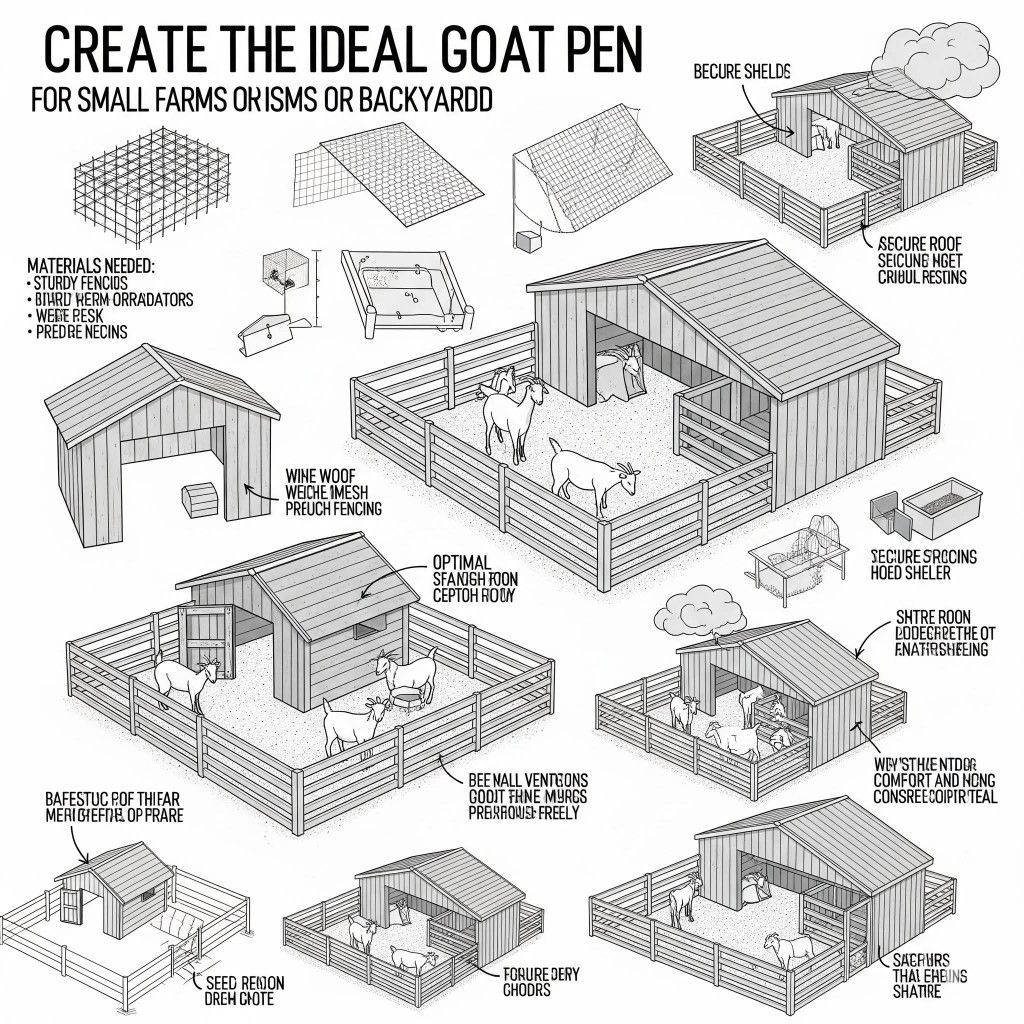By: Agri-Tech Living News Desk
Goat farming has always been a cornerstone of sustainable living, but in 2025, it’s being revolutionized with smarter and safer housing designs. A new illustrated guide—“Create the Ideal Goat Pen”—is quickly gaining attention among farmers and homesteaders, showing how small investments in design can dramatically improve animal welfare, farm efficiency, and backyard sustainability.
This guide breaks down the key components of a modern goat pen, making it easier for small farmers and backyard livestock keepers to build durable, comfortable, and predator-proof shelters. Let’s dive into the step-by-step breakdown of what makes the “ideal goat pen.”
1. Strong Foundation: The Materials
According to the guide, the essential materials include:
- Sturdy fences (wood or metal)
- Welded wire panels or mesh fencing
- Predator-proof roofing materials
- Drainage flooring options
These ensure the pen is long-lasting, safe, and hygienic.
2. Fencing – The First Line of Defense
Goats are clever escape artists. The design emphasizes:
✔ Wire mesh fencing to prevent climbing out.
✔ Posts set deep into the ground for stability.
✔ Smooth, chew-resistant wood to avoid damage from constant nibbling.
This fencing doesn’t just contain goats—it also keeps out predators like dogs, coyotes, and foxes.
3. Roofing & Shelter
Each design in the guide includes a secure sloping roof, which serves two major purposes:
- Protection from rain, wind, and snow
- Ventilation for airflow
A covered shelter area ensures goats always have a dry, shaded place, vital for both health and comfort.
4. Space Planning
The guide suggests:
- Enough open space for goats to roam freely.
- A secure shed for sleeping and resting.
- Separate feeding and watering areas to maintain hygiene.
Goats thrive when they have space to exercise. This design acknowledges their playful, climbing nature by offering room for movement and enrichment.
5. Ventilation & Drainage
Ventilation is critical to avoid moisture buildup, which can lead to diseases. The guide recommends:
- Raised flooring or gravel-based ground to improve drainage.
- Strategic air vents in walls and roofs.
This prevents pens from becoming damp and reduces ammonia buildup from waste.
6. Feeding & Watering Stations
The plans also highlight:
- Raised troughs or feeders – keep food clean and reduce waste.
- Fresh water supply – placed away from bedding to prevent contamination.
Goats are prone to knocking things over, so sturdy feeders are a must.
7. Comfort & Enrichment
Goats are social animals. The pen should:
- Provide enough room for multiple goats to avoid crowding.
- Include climbing structures, platforms, or rocks to satisfy their natural instincts.
- Offer privacy areas for nursing mothers or weaker goats.
8. Predator-Proofing
Safety is non-negotiable. The ideal goat pen uses:
- Lockable gates
- Buried fencing edges to stop digging predators
- Covered tops to protect from aerial threats like hawks
9. Design Options in the Guide
The illustrations feature multiple pen designs, from compact backyard setups to larger farm enclosures. Each balances cost and functionality, ensuring farmers can pick the right fit.
For example:
- Small farm design – includes a wide roof and extended fenced yard.
- Backyard pen – compact, with easy cleaning access.
- Family-sized pen – accommodates several goats with dedicated feeding zones.
10. Why This Matters in 2025
The surge in backyard farming, fueled by a desire for organic food, self-sufficiency, and eco-friendly living, has created a demand for smarter livestock housing solutions.
The Ideal Goat Pen Guide empowers farmers to:
- Improve goat health and productivity.
- Reduce farm maintenance costs.
- Build attractive, efficient shelters that blend with modern backyards.
Conclusion
The “Ideal Goat Pen” isn’t just about keeping goats safe—it’s about designing smarter, more sustainable farming practices. By following this guide, even first-time goat owners can create a low-maintenance, predator-proof, and comfortable environment that supports healthier and happier animals.
This design trend is a clear sign that small-scale farming is entering a new era—one where practicality meets innovation, and every backyard can become a hub of sustainable living.
